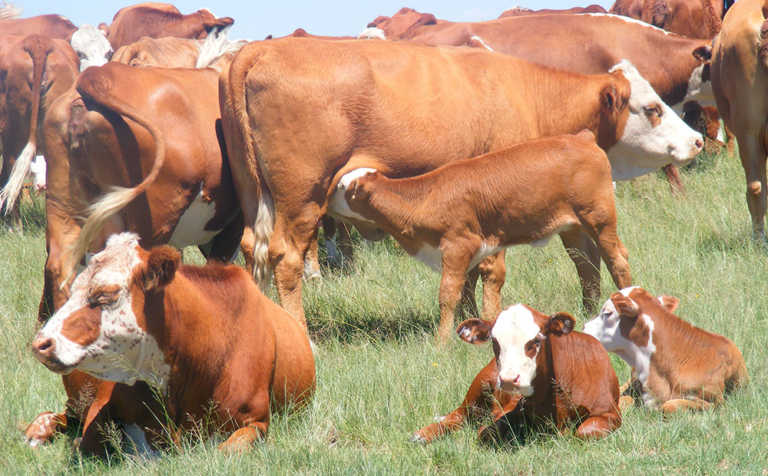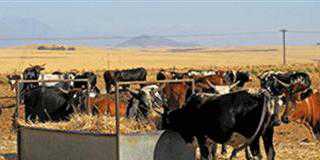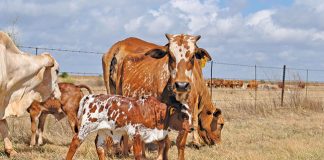
Photo: Annelie Coleman
The National Beef Recording and Improvement Scheme (NBRIS), managed by the Agricultural Research Council (ARC), has the tools to help farmers become commercially productive and make the transition from developing to commercial farming.
A farmer who produces and delivers weaner calves to a feedlot can be considered a commercial farmer.
READ Tips for stress-free livestock transporting
For commercial farmers to be profitable, they must produce the optimal number and weight of weaner calves/cows mated at the lowest possible cost. Weaner calves then need to be marketed as economically as possible directly after weaning and at the optimal weight.
To achieve this, the fertility of the cow herd and the growth ability of calves from birth to weaning must be considered. Post-weaning growth is of particular importance for the feedlot industry.
The basis of good reproduction management is excellent record-keeping; this will enable breeders to make informed selection decisions to achieve their objectives.
Phases A and B of NBRIS provide a platform for commercial breeders to measure animals in phases.
Supplying information to the national database
Certain management practices, such as weighing animals at birth and weaning, are already carried out by farmers, but it is important that these statistics be made available to the national database, the Integrated Recording and Genetic Information System (INTERGIS).
Once this data is processed, useful information is extrapolated for producers in the form of reports on the productivity and efficiency of the herd.
This information enables producers to decide which animals to cull. It is therefore important to implement and maintain management practices in a structured way to ensure that meaningful data is produced for these reports.
The most important aspect in this regard is establishing a fixed breeding season of a maximum of three months. The period, determined according to the regional rainy season, must be planned to utilise natural grazing at its peak so that it can meet the nutritional needs of lactating cows.
It is also important to maintain the condition and weight of cows and heifers at the start of the breeding season. A lactating cow’s nutritional needs peak for six weeks after the birth of a calf.
Phase A
The births of all calves should be recorded and the animals identified in an appropriate on-farm system, such as ear-tags that indicate the date of birth. Birth dates and weights should be captured on INTERGIS.
It is also important to record stillborn calves in order to accurately calculate traits such as age at first calving and the inter-calving period. These are the most important traits to measure in a herd, as they indicate cows’ reproduction and fertility rates.
READ SA Stud Book lauds 2017’s best breeders
Cow weights should be measured at the birth or weaning of a calf, which is usually the easiest and most practical time to weigh cows.
The aim of a weaner production system is to achieve optimal weaning weights at the lowest cost per breeding animal. For this reason, it is also important to limit cow weights to minimise input costs.
Selection and management should therefore focus on improving production or output. The objective is to wean a calf that weighs at least 45% of the dam’s body weight.
Weaning usually takes place at between seven or eight months, and the ARC system provides a weaning weight list on which all calves born in the previous calving season are recorded.
Weaning weights, as well as the date of weaning, should be recorded on the list and returned to the ARC to be captured on INTERGIS.
The standard 205-day weight, as well as an index value of the performance of the calf compared with the average performance of the group, are then calculated for each calf in the weaning group.
The age of animals in the same weaning group will invariably vary by about three months due to the three-month breeding season. This can complicate the comparison of animals based on performance within the weaning group.
Older animals will always have an advantage over younger ones, and there will also be a difference in the weights of bulls and heifers.
For this reason, weaning ages are standardised to a 205-day age and calculated for the entire weaning group.
A new weaning report, the weaning test report, is then generated; this shows the weaning weight, adjusted 205- day weight and 205-day weight index, enabling the breeder to fairly compare animals based on their growth performance.
Weaning production report
The weaning index for each animal is derived from its performance, expressed as a percentage compared with the group average, which is always 100%.
Animals with a weaning index greater than 100 are above average and calves below 100 are below average.
The weaning test report contains the complete weaning group’s weaning weights, 205-day weights, and weaning indices for comparison purposes.
The report thus enables breeders to identify calves with the best growth ability within the group, and identify heifers for potential replacement of older cows that have become less efficient over time.
The weaning weight of a calf is an indication of its own genetic ability to grow, as well as the efficiency of its mother’s milk production.
Phase B
Commercial farmers generally market all bull calves after weaning. Heifers are usually marketed after the preliminary selection of potential replacement heifers after weaning.
This means that mainly heifers will remain and proceed to phase B1 (12 months of age) and B2 (18 months of age).
The post-weaning production report is an excellent test for selection of replacement heifers at the age of 12 months and 18 months. The Phase B test is an on-field test to measure adapted female animals’ growth performance.
Reproduction Report
The reproduction or breeding herd report contains a list of all active cows and heifers older than 24 months.
Reproduction information such as the number of calves, age at first calving, inter-calving period, and the average weaning index for all calves weaned per cow, is included in this report.
The average weaning index per cow is very useful for determining the efficiency of the cow. If a cow is not efficient enough, or does not produce a calf every year, it may be better to replace her with a good-quality heifer.
Age at first calving is a fertility trait that enables the breeder to identify a cow that calves earlier in the calving season and therefore needs more recovery time to ensure she is in better condition for the next mating season. – Annelie Coleman
For NBRIS enquiries, email Frans Jordaan at [email protected], or Dr Ben Greyling at [email protected].
For INTERGIS enquiries, email Corrie van Zyl at [email protected], or Saul van Wyk at [email protected].
Sources: Dr Ben Greyling, Saul van Wyk, Corrie van Zyl and Graham Buchanan.













